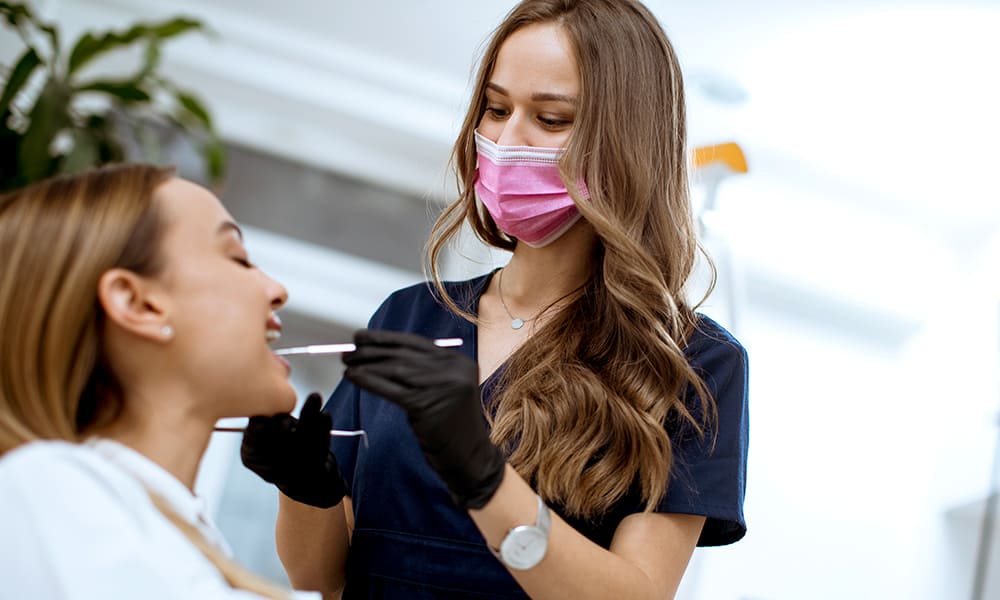Periodontics
Oral Pathology

The dentist will often do an oral examination as part of a full first examination and periodic checkups or oral pathology. An oral cancer exam involves the detection and treatment of diseases affecting the oral and maxillofacial areas.
The mucosa, an unique kind of skin that should be smooth in texture and pink in color, generally lines the soft tissues of the mouth. Any change in the mucosa’s tone or texture might be the first indicator of a pathogenic condition. These modifications may affect the mouth, neck, and face. For example, the lips, gums, tongue, and so on. Oral cancer is the most severe of these pathologic alterations (which may or may not be painful). However, there are many other typical pathologic issues as well.
- Geographic Tongue. This is a disorder where the tongue loses papillae (small bumps) in various places, giving it a map-like look. It is sometimes referred to as benign migratory glossitis or erythema migrans. The common symptom of this disease is red, well-defined spots on or around the sides of the tongue. Increased sensitivity to particular chemicals is brought on by the red patches, which can appear like an ugly rash and may appear and disappear for periods of hours to months at a time.
- Median palatal cyst. This is simply a skin sac filled with fluid and has developmental origins. It often occurs in the center of the palate and can be quite uncomfortable.
- Hairy Tongue: A yeast infection or bacterial overgrowth in the mouth can make the tongue seem hairy and dark. Poor dental hygiene, prolonged or frequent antibiotic usage, or radiation therapy to the head or neck are the typical causes of this condition. Additionally, HIV-positive individuals and intravenous drug users frequently experience it. Treatment for hairy tongue may or may not be necessary.
Treatment of Pathological Diseases
The pathological modifications felt in the oral area are often unpleasant and disfiguring but rarely life threatening. The odds of survival are about 80% if an initial diagnosis is made. Although oral cancer is on the rise, particularly among males.
Any cancer that affects the tongue, mouth, and lower cheek region is referred to as oral cancer. Getting prompt treatment when abnormalities are initially discovered may be the difference between life and death since a dentist cannot definitively diagnose a pathological condition without collecting a biopsy sample of the affected region. There are other solutions available for less severe issues, including:
- Antibiotics – The dentist may recommend an antibiotic dosage to restore the mucosa to its normal state in the event of a bacterial infection or prolonged pain. This will make you feel better and less painful.
- Diluted hydrogen peroxide – The dentist may advise using a mouthwash with diluted hydrogen peroxide if poor dental hygiene is affecting the soft tissue. This will reduce halitosis (bad breath) and destroy more germs than conventional mouthwash.
- Oral surgery – The dentist can choose to totally remove any cysts or other abnormal, non-cancerous growths the patient possesses. Depending on where the cyst is, this can increase comfort levels, solve breathing issues, and make speaking much easier.
Oral Examinations
During oral examination, the dentist examines the soft tissue of the mouth, and any changes will be carefully noted. In the event that there are cell alterations, the dentist will take a biopsy of the troubled region and send it off for laboratory experts to examine. The dentist can choose the best course of action after clear results are acquired.
Screenings For Oral Cancer
A comprehensive or recall (check-up) checkup typically includes an oral cancer screening. The screening process is quick and painless. A laser light will be used by the dentist or hygienist to examine the soft tissue for any possible mouth cancer-related cell changes. If cell alterations are found, a tiny biopsy will be performed and sent to a lab for analysis. Excision (removal) will often be carried out if the biopsy reveals the presence of oral cancer.
We encourage you to call us right away to set up an appointment if you are feeling any pain or other symptoms that bother you.

Book Appointment
Do you need to see a dentist? We’re here to help. Book your next dental visit with ease.
FREE IMPLANT CONSULTATION
CATEGORIES
- Cracked tooth
- Avulsed tooth
- Broken, lost, or loose crown
- Gum abscess
- Broken denture
- Toothache
- Head injury such as a fall
- Loose implant
FOLLOW US

Book Appointment
Do you need to see a dentist? We’re here to help. Book your next dental visit with ease.

Book Appointment
Do you need to see a dentist? We’re here to help. Book your next dental visit with ease.
FREE IMPLANT CONSULTATION
Considering implants?
Schedule a 30-minute FREE, no-obligation office consultation with us.
Call (289) 815-5385 or complete an online appointment request.
CATEGORIES
- Cracked tooth
- Avulsed tooth
- Broken, lost, or loose crown
- Gum abscess
- Broken denture
- Toothache
- Head injury such as a fall
- Loose implant
FOLLOW US
Take a peek inside our dental office.
What Our Practice Looks

Mon - Thu: 8:30 AM - 5:00 PM
Alternating Fri: 10:00 AM - 3:00 PM
Follow Us
Contact Us

Mon - Thu: 8:30 AM - 5:00 PM
Alternating Fri: 10:00 AM - 3:00 PM
Follow Us
Contact Us
© All Rights Reserved aestheticimplantdentistry.ca
Privacy Policy | Terms of Use | Sitemap
A Dentistfind Website



